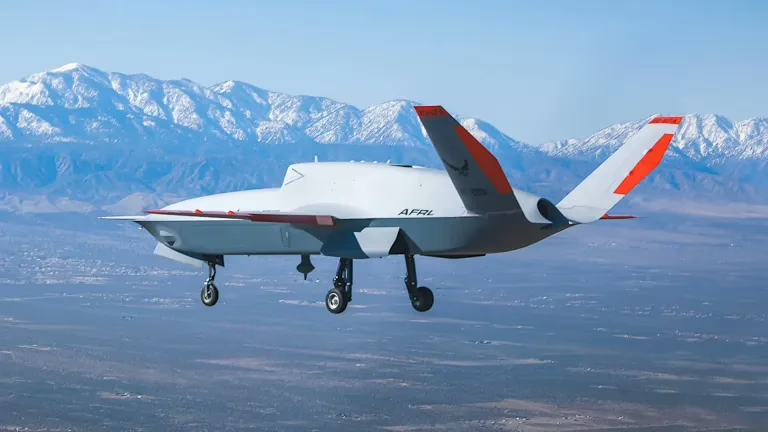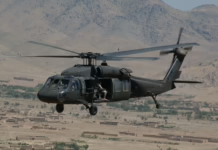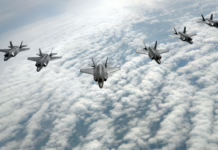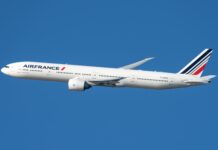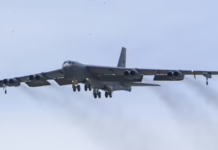San Diego defense contractor partners with German subsidiary to build YFQ-42A variant as concerns grow over U.S. alliance reliability.
General Atomics Aeronautical Systems will partner with its German affiliate to produce a European-built variant of its prototype autonomous fighter jet, the company announced July 17, as NATO allies increasingly seek defense alternatives amid questions about American commitment.
The San Diego-based uncrewed aircraft manufacturer plans to build a derivative of the YFQ-42A autonomous fighter through General Atomics Aerotec Systems GmbH, located in Oberpfaffenhofen near Munich. The jets will be “assembled in Europe, with European mission systems,” according to GA-ASI.
GA-ASI Chief Executive Linden Blue said the company aims to leverage European defense expertise in the partnership. “We’re eager to combine our uncrewed aircraft system expertise with the airborne sensor and weapons system expertise of the European defence industry,” Blue said.
The European production move positions GA-ASI to compete for international contracts as the company pursues the Pentagon’s Collaborative Combat Aircraft program. GA-ASI is among the finalists developing the first autonomous fighter platform for the U.S. Air Force, with the YFQ-42A prototype scheduled to complete its maiden flight within weeks.
The single-engine jet builds on the XQ-67A platform, which GA-ASI developed as a foundation for future uncrewed variants. That aircraft completed its first flight in 2024. GA-ASI’s prototype made its international debut at the 2025 Paris air show with a full-scale model.
Blue emphasized the production advantages of an established design. “With a proven CCA design already in production today, these systems will be delivered in significant quantity with high-technology European inputs to build and sustain affordable mass for NATO’s fighter forces,” he said.
The announcement follows rival Anduril’s partnership with German defense manufacturer Rheinmetall to offer a European-built version of Anduril’s Fury uncrewed fighter. That aircraft serves as the basis for Anduril’s YFQ-44A prototype, which competes directly against GA-ASI’s YFQ-42A for the Air Force contract. Anduril also expects to complete its first CCA test flight in the coming weeks.
GA-ASI’s German facility already provides maintenance for the German army’s NH Industries NH90 attack helicopters and overhauls Honeywell TPE-331-10 engines that power Dornier 228 aircraft and GA-ASI’s MQ-9A/B remotely piloted aircraft. The site also assembles Dornier 228 twin-engine turboprops.
GA-ASI says this established capability provides a “jump start for European uncrewed fighter development” and enables fast acquisition timelines for potential customers.
The push for European-made autonomous fighters reflects growing concerns among NATO members about alliance reliability following suggestions from President Donald Trump that he might not support allies who inadequately fund their own defense. This uncertainty has prompted increased European military spending and calls from leaders like French President Emmanuel Macron to prioritize European manufacturers.
However, sourcing uncrewed fighters solely from European companies presents challenges. U.S. companies currently lead in developing pilotless fighters, which are expected to serve as force multipliers for existing combat aircraft and next-generation designs like Boeing’s F-47 and the Tempest fighter being jointly developed under the UK-Italy-Japan Global Combat Air Programme.
In the United States, CCA prototypes like the Kratos XQ-58A have successfully integrated with fourth-generation fighters and fifth-generation Lockheed Martin F-35s, demonstrating operational capabilities.
European autonomous collaborative platforms remain largely in design phases, with BAE Systems and Dassault Aviation planning demonstrations in the coming years. Turkish Aerospace and Baykar Technologies represent exceptions, both flying uncrewed combat aircraft designed to operate alongside Turkey’s indigenous Kaan fighter, a fifth-generation-style jet under development by Turkish Aerospace.
Australia has emerged as a leader in low-cost pilotless fighters outside the United States. The Royal Australian Air Force and Boeing regularly conduct flights of the jointly developed MQ-28 Ghost Bat, with recent tests demonstrating integration capabilities with Australian Boeing E-7A Wedgetail airborne early warning and control aircraft.

Key Takeaways
- General Atomics will produce European-built variants of its YFQ-42A autonomous fighter through its German subsidiary, targeting NATO customers seeking alternatives to U.S.-made systems.
- The move follows growing European concerns about alliance reliability after President Trump suggested conditional NATO support based on defense spending levels.
- GA-ASI competes directly with Anduril, which also announced a European production partnership, for the Pentagon’s Collaborative Combat Aircraft program.
- Both companies expect first flights of their prototype fighters within weeks as the Air Force selects its first autonomous combat aircraft.
- U.S. firms currently dominate autonomous fighter development, while European programs remain largely in design phases.



